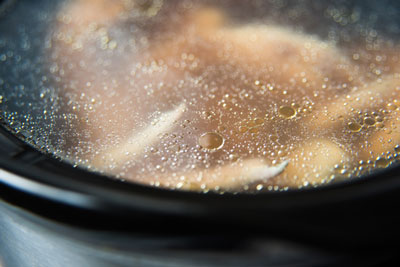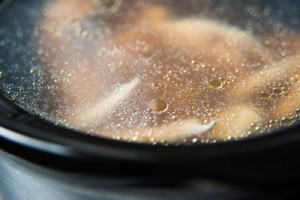Coctio offers solution for industrial bone broth production
- Like
- Digg
- Del
- Tumblr
- VKontakte
- Buffer
- Love This
- Odnoklassniki
- Meneame
- Blogger
- Amazon
- Yahoo Mail
- Gmail
- AOL
- Newsvine
- HackerNews
- Evernote
- MySpace
- Mail.ru
- Viadeo
- Line
- Comments
- Yummly
- SMS
- Viber
- Telegram
- Subscribe
- Skype
- Facebook Messenger
- Kakao
- LiveJournal
- Yammer
- Edgar
- Fintel
- Mix
- Instapaper
- Copy Link
Posted: 29 September 2015 | Victoria White | 5 comments
With Coctio’s manufacturing line, bone remains can be used as raw material for multiple commercial end products, including traditionally simmered bone broth…


Finnish company Coctio has taken previously unproductive bone waste and upgraded it to bring significant income for the food industry.


With Coctio’s manufacturing line, bone remains can be used as raw material for multiple commercial end products, including traditionally simmered bone broth. Coctio is the only company in the world that offers a solution for producing bone broth industrially.
The consumption of fresh meat is increasing in Europe every year, according to the Canadean Database, and food manufacturers produce an enormous amount of beef, pork, poultry and fish bones as a by-product to their core business. Bone remains management and reducing bone waste are major environmental issues that the food industry continuously struggles with.
“[The] Coctio method is a completely new way to utilise food industry side streams economically and ecologically. With our innovative manufacturing line, food manufacturers, meat processing plants and slaughterhouses can use authentic ingredients, such as animal and fish bones, to make additive free culinary broths and sauces,” explained Kai Iiskola, CEO of Coctio.
Non-processed raw food such as bone broth is one of the fastest growing healthy food trends. Consumers are also more aware of the environmental and sustainability issues around food manufacturing, which affects their purchasing decisions.
Bone broth is a good source of protein and other nutrients
Bone broth serves as good source for protein and many other nutrients like calcium, magnesium and vitamins C and B. However, in hectic modern life, there is seldom time to simmer authentic broth at home, and many people turn to stock cubes instead. While bone broth is made by slowly simmering natural ingredients with no additives needed, stock or bouillon cubes often contain chemically manufactured flavour enhancers. They may also contain a lot of additives, preservatives and salt, losing most of the health benefits and natural gelatin.
Bone broth and sauces are the most significant end products produced with the Coctio method. The bone material that is left over after the simmering process can also be separated and further processed in the Coctio manufacturing line.
Iiskola added. “With the Coctio method, food industry bone remains can reach a profit rate up to 300 per cent. This is because the leftovers from the bone broth simmering process can be refined into other end products, such as heat energy, industrial fat and fertilizer. The versatility of the end products can come as a surprise: there are many ways to make profit from bone remains and at the same time save money from bone disposal costs and heating.”
Coctio bone broth manufacturing line responds well to the varying needs of the several branches of food processing industry. Production capacity can quickly be expanded by implementing additional modules, such as oven and cooker modules to the manufacturing line with quick and free of charge installation. The highly automated line is easy to use, program and control, always producing culinary end products of premium quality.





Dear Tanja
Grateful if you send me details of Coctio broth manufacturing line with description of the process.
There is a company that makes quality frozen bone broth and ships it to you so you don’t have to make it yourself; it takes a long time and can get really involved and messy. It’s great that this Finnish company is finding solutions, but that doesn’t do much for us here in the states that would like more access to good bone broth. If you want super tasty and really convenient, high quality bone broth with lots of rich collagen, check out Au Bon Broth. http://www.aubonbrothbonebroth.com
Hi Jordan,
Thank you so much for your comment and information about Au Bon Broth. I’m Tanja Immonen and I represent the Finnish company Coctio Ltd, which this news is telling. I work at Coctio as a marketing manager.
We at Coctio are pleased and very glad to notice that you in Au Bon Broth company are operating and doing great work around the same passion than Coctio is also doing with. We both want to advance healthy food markets, especially authentic and healthy bone broth and sauce products and want to make them available for everyone.
We help food companies by offering an easy solution for industrial bone broth production. In other words, we’ re a professional food industry equipment supplier by manufacturing Coctio bone broth and sauce manufacturing lines. We deliver the lines from our production plant in Finland to the international market for to make bone broth (stocks, soup, sauces) production possible for every food company who wants to develop its business around utilizing bone by-products and make quickly income with them.
The bone broths produced with a Coctio line and with Chef Kai Iiskola’s culinary and professional expertise, are premium quality, culinary taste end products that contain no preservatives.
I’m always happy to answer questions.
Br,
Tanja Immonen
Coctio Ltd
Could you please email me more information about this? [email protected]
Thank you.
Hi QW,
I will email you more information about Coctio services and a manufacturing line to produce authentic bone broths and sauces industrially with a chef’s traditional manner and recipes. Also, please visit our website to learn about Coctio as a food industry partner and how the bone broth manufacturing line is helping food companies. Read more: http://www.coctio.com.
I visited your Balanced and Bright Bone Broth website and found my delight you are also operating in the same healthy food business than Coctio. We just are a food industry equipment supplier for to produce broths and sauces.
Br,
Tanja Immonen
Coctio Ltd